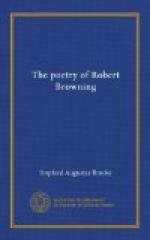Her eyes were on the ground; ’tis July, strong
Now; and, because white dust-clouds overwhelm
The woodside, here, or by the village elm
That holds the moon, she meets you, somewhat pale.
And here are two pieces of the morning, one of the wide valley of Naples; another with which the poem ends, pure modern, for it does not belong to Sordello’s time, but to our own century. This is from the fourth book.
Broke
Morning o’er earth;
he yearned for all it woke—
From the volcano’s vapour-flag,
winds hoist
Black o’er the spread
of sea,—down to the moist
Dale’s silken barley-spikes
sullied with rain,
Swayed earthwards, heavily
to rise again.
And this from the last book—
Lo, on a heathy brown and
nameless hill
By sparkling Asolo, in mist
and chill,
Morning just up, higher and
higher runs
A child barefoot and rosy.
See! the sun’s
On the square castle’s
inner-court’s low wall
Like the chine of some extinct
animal
Half-turned to earth and flowers;
and through the haze,
(Save where some slender patches
of grey maize
Are to be over-leaped) that
boy has crossed
The whole hill-side of dew
and powder-frost
Matting the balm and mountain
camomile.
Up and up goes he, singing
all the while
Some unintelligible words
to beat
The lark, God’s poet,
swooning at his feet.
As alive, and even clearer in outline than these natural descriptions, are the portraits in Sordello of the people of the time. No one can mistake them for modern folk. I do not speak of the portrait of Sordello—that is chiefly of the soul, not of the body—but of the personages who fill the background, the heads of noble houses, the warriors, priests, soldiers, singers, the women, and chiefly Adelaide and Palma. These stand before us as Tintoret or Veronese might have painted them had they lived on into the great portrait-century. Their dress, their attitudes, their sudden gestures, their eyes, hair, the trick of their mouths, their armour, how they walked and talked and read and wrote, are all done in quick touches and jets of colour. Each is distinct from the others, each a type. A multitude of cabinet sketches of men are made in the market-places, in castle rooms, on the roads, in the gardens, on the bastions of the towns. Take as one example the Pope’s Legate:
With eyes, like fresh-blown
thrush-eggs on a thread,
Faint-blue and loosely floating
in his head,
Large tongue, moist open mouth;
and this long while
That owner of the idiotic
smile
Serves them!
Nor does Browning confine himself to personages of Sordello’s time. There are admirable portraits, but somewhat troubled by unnecessary matter, of Dante, of Charlemagne, of Hildebrand. One elaborate portrait is continued throughout the poem. It is that of Salinguerra, the man of action as contrasted with Sordello the dreamer. Much pains are spent on this by Browning. We see him first in the streets of Ferrara.




